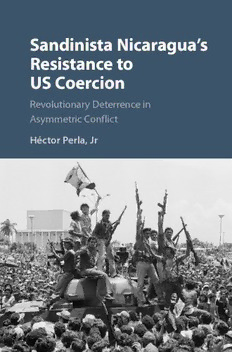
Sandinista Nicaragua’s Resistance to US Coercion: Revolutionary Deterrence in Asymmetric Conflict PDF
Preview Sandinista Nicaragua’s Resistance to US Coercion: Revolutionary Deterrence in Asymmetric Conflict
How was the Sandinista National Liberation Front (FSLN) of Nicaragua P e r able to resist the Reagan Administration’s coercive efforts to rollback their l a , Sandinista Nicaragua’s revolution? Héctor Perla challenges conventional understandings J r of this conflict by tracing the process through which Nicaraguans, both at home and in the diaspora, defeated U.S. aggression in a highly unequal tS Resistance to o a confrontation. He argues that beyond traditional diplomatic, military, and Un domestic state policies a crucial element of the FSLN’s defensive strategy Sd US Coercion i was the mobilization of a transnational social movement to build public Cn oi opposition to Reagan’s policy within the United States, thus preventing s et ra Revolutionary Deterrence in further escalation of the conflict. Using a contentious politics approach c iN the author reveals how the extant scholarly assumptions of international o i Asymmetric Conflict nc relations theory have obscured some of the most consequential dynamics a r of the case. This is a fascinating study illustrating how supposedly a g Héctor Perla, Jr powerless actors were able to constrain the policies of the most powerful u nation on earth. a ’ s R Héctor Perla is assistant professor for the Latin American and Latino e s Studies department at the University of California, Santa Cruz. i s t a n c e Sandinista Nicaragua’s Resistance to US Coercion How was the Sandinista National Liberation Front (FSLN) of Nicaragua able to resist the Reagan Administration’s coercive efforts to rollback its revolution? Héctor Perla challenges conventional understandings of this confl ict by tracing the process through which Nicaraguans, both at home and in the diaspora, defeated U.S. aggression in a highly unequal confrontation. He argues that beyond traditional diplomatic, military, and domestic state policies, a crucial element of the FSLN’s defensive strategy was the mobilization of a transnational social movement to build public opposition to Reagan’s policy within the United States, thus preventing further escalation of the confl ict. Using a contentious politics approach the author reveals how the extant scholarly assump- tions of international relations theory have obscured some of the most consequential dynamics of the case. This is a fascinating study illustrat- ing how supposedly powerless actors were able to constrain the poli- cies of the most powerful nation on earth. Héctor Perla is a Senior Research Fellow at the Council on Hemispheric Affairs (COHA) and holds an appointment as a Steiger Visiting Scholar through the American Political Science Association’s Congressional Fellowship Program Sandinista Nicaragua’s Resistance to US Coercion Revolutionary Deterrence in Asymmetric Confl ict HÉCTOR PERLA JR. Council on Hemispheric Affairs (COHA) 32 Avenue of the Americas, New York NY 10013 Cambridge University Press is part of the University of Cambridge. It furthers the University’s mission by disseminating knowledge in the pursuit of education, learning, and research at the highest international levels of excellence. www.cambridge.org Information on this title: w ww.cambridge.org/9781107113893 © Héctor Perla Jr. 2016 This publication is in copyright. Subject to statutory exception and to the provisions of relevant collective licensing agreements, no reproduction of any part may take place without the written permission of Cambridge University Press. First published 2016 Printed in the United States of America by Sheridan Books, Inc. A catalog record for this publication is available from the British Library. Library of Congress Cataloguing in Publication Data Names: Perla, Héctor, Jr., author. Title: Sandinista Nicaragua’s resistance to US coercion : revolutionary deterrence in asymmetric confl ict / Héctor Perla Jr., Council on Hemispheric Affairs (COHA). Description: New York, NY: Cambridge University Press, [2016] | Includes bibliographical references and index. Identifi ers: LCCN 2016023215 | isbn 9781107113893 (hardback : alk. paper) Subjects: LCSH: Nicaragua – Politics and government – 1979–1990. | Nicaragua – Foreign relations – United States. | Counterrevolutionaries – Nicaragua – History – 20th century. | United States – Foreign relations – Nicaragua. | Deterrence (Strategy) – Case studies. | Asymmetric warfare – Case studies. | Solidarity – Nicaragua– History – 20th century. | Peace movements – United States – History – 20th century. | Volunteers – Nicaragua – History – 20th century. | United States – Politics and government – 1945–1989. Classifi cation: LCC F1528.P48 2016 | DDC 972.8505/3–dc23 LC record available at h ttps://lccn.loc.gov/2016023215 ISBN 978-1-107-11389-3 Hardback Cambridge University Press has no responsibility for the persistence or accuracy of URL s for external or third-party Internet Web sites referred to in this publication and does not guarantee that any content on such Web sites is, or will remain, accurate or appropriate. Contents List of Figures page vi List of Tables vii Preface ix Acknowledgments xvii Introduction 1 1 History of U.S.–Nicaragua Relations 18 2 International Relations Theory, Asymmetric Conflicts, and Contentious Politics 40 3 Revolutionary Deterrence 75 4 Challenging Reagan 92 5 Media Framing and Opposition to the Use of Force in U.S. Foreign Policy 122 6 Activating Public Opinion 155 7 Stopping Rollback: Evidence of Revolutionary Deterrence on Congressional Opposition, Reagan, and Reagan Administration Decision Making 181 Conclusion: Scope Conditions and Implications of Revolutionary Deterrence 209 Epilogue: Postrevolutionary Developments 221 Index 227 v Figures 6.1 Cross-tabulations of letter’s issue position and letter type page 166 6.2 Cross-tabulations of letter’s issue position and reference cue 169 6.3 Cross-tabulations of letter’s issue position and letter frame 170 vi Tables 5.1 Regression Models Measuring the Impact of Media Framing on Public Support for the use of Force Abroad page 149 7.1 Number of Congressional Hearings on Rollback Countries (1981–1990) 188 7.2 Number of CAPSM Organizations in the District of Democrats Supporting Contra Aid 200 7.3 Number of CAPSM Organizations in the District of Republicans Opposing Contra Aid 201 vii
